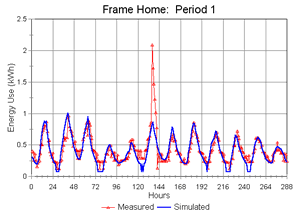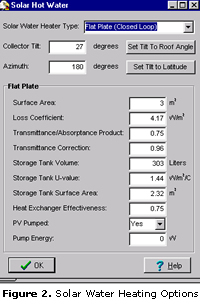
Reference Publication: Vieira, Robin, "Sunup to Sundown," Software/Web column for HomeEnergy, Berkeley, CA, January/February 2003, pp 10,11. Figures and references expanded. Disclaimer: The views and opinions expressed in this article are solely those of the authors and are not intended to represent the views and opinions of the Florida Solar Energy Center. |
Sunup to Sundown - EnergyGauge USA 2.0
Robin Vieira
Florida
Solar Energy Center (FSEC)
FSEC-GP-192-03

You need special tools to design high-performance homes - residences where energy efficiency creates greater comfort, health, and energy savings. Making decisions about energy efficiency requires the accurate calculation of energy use and demand, and the comprehensive evaluation of proposed improvements.
A new software tool helps meet these requirements. EnergyGauge USA, an hourly simulation tool for the design and analysis of high-performance homes, performs detailed hourly simulation analysis for energy use, ratings and code calculations. Version 2.0 adds many features to the first-generation product, including thermal mass, photovoltaic (PV) system simulation, solar water heating, and detailed hourly outputs.
The software, designed by the Florida Solar Energy Center (FSEC), provides a user-friendly front end to simulate a residential building. It uses the DOE-2 engine with new functions, including a detailed attic model, thermal distribution systems, and HVAC performance modeling (see Parker et. al, 1999). The software has three entry modes: International Energy Conservation Code (IECC), rating, and detailed. Under detailed entry mode, all inputs are available to the user for altering. Code and rating entry modes do not allow certain variables to be altered due to the governing rules. For a typical building, Version 2 computes an annual energy analysis in less than five seconds on a 2.4 Ghz machine.
Calculations include annual energy use, IECC calculation, energy ratings, system-sizing based on ACCA Manual J seventh edition, and economic analysis of improvements. The program has passed the HERS BestTest (Fairey et. al), a verification procedure developed by the National Renewable Energy Laboratory (NREL) to determine the accuracy and effectiveness of the energy load prediction capability of software tools used for home energy ratings. EnergyGauge USA has also been verified against measured data (see Figure 1 and Fuehrlein, et. al.).
 |
Figure
1. Measured and modeled temperature data using EnergyGauge USA. The measured peak on day 140 was during SF6 infiltration testing by staff and was not modeled by the software. |
One drawback of many design tools has been their inability to include windows and doors in an accurate, easy manner. Wall descriptions are now entered by orientation with doors and windows located within a wall. Even insect screens and their shading effects are included for windows. In addition to the various wall constructs, a separate thermal mass input screen has been added to allow for greater accuracy of passive solar heating options. Evaporative cooling systems are now modeled as well. Utility rate inputs have been expanded. Waterheater tank wraps and refrigeration have been added to refine estimates of appliance energy use.
In the pursuit of zero energy homes, two important renewable strategies are featured with detailed simulations: solar water heating and solar-electric systems (PV).
Solar Thermal Systems
 Most
building simulations use simple solar savings fractions for solar
thermal systems, which do not account for climate-specific performance.
EnergyGauge USA 2.0 allows users to enter detailed descriptions
for solar waterheating systems (see Figure 2) so users can match
solar thermal systems with climate-specific performance. The model
accounts for pumping energy or allows for a PV pump to be specified.
The program provides default solar inputs that enable users to
explore the potential for solar without having detailed system
specifications.
Most
building simulations use simple solar savings fractions for solar
thermal systems, which do not account for climate-specific performance.
EnergyGauge USA 2.0 allows users to enter detailed descriptions
for solar waterheating systems (see Figure 2) so users can match
solar thermal systems with climate-specific performance. The model
accounts for pumping energy or allows for a PV pump to be specified.
The program provides default solar inputs that enable users to
explore the potential for solar without having detailed system
specifications.
Photovoltaic Systems
The photovoltaic system is modeled with Sandia National Laboratory’s PVForm, providing a detailed analysis based on the module, orientation, tilt, and inverter. Databases of current PV modules and inverters are included with the software. A new set of reports, pertinent to PV, has been added (see peak summer day performance in Figure 3).
Reporting
System-sizing and the evaluation of alternative designs are essential for efficiency. EnergyGauge always included a multitude of reports, from a simple annual simulation summary to system sizing reports and comparison reports for input, energy use and economic analysis. Version 2.0 adds the ability to export hourly data to a spreadsheet or database, as well as new hourly reports and graphs. Users can select any day of the year or any consecutive period, graph a daily profle, and compute minimum, maximum, average and total values for the parameter. These new reporting and exporting features allow greater use of the software for utility planning programs.
REFERENCES
Fuehrlein,
B., S. Chandra, D. Beal, D. Parker, and R.
Vieira, “Evaluation of EnergyGauge USA: A Residential
Energy Design Software, Against Monitored Data,”
Proceedings of ACEEE 2000 Summer Study,
pp 2.115 _ 2.126, American Council for an Energy Efficient
Economy, Washington, DC, August 2000.
Fairey, P., R. Vieira, and D. Parker, “Validation of EnergyGauge USA Using the HERS BESTEST,” Research Report No. FSEC_RR_55_00, Florida Solar Energy Center, Cocoa, FL, October 17, 2000.
Parker, D., P. Broman, J. Grant, L. Gu, M. Anello, R. Vieira and H. Henderson, “EnergyGauge USA, A Residential Building Energy Design Tool.” Proceedings of Building Simulation '99, Kyoto, Japan. International Building Performance Simulation Association, Texas A&M University, College Station, TX, September 1999.
